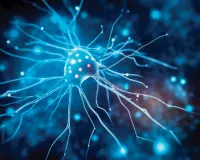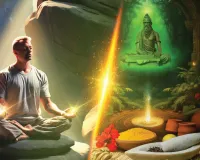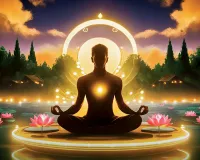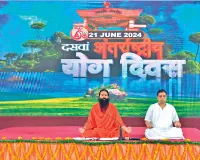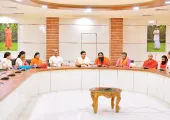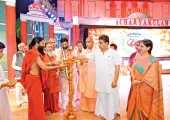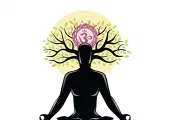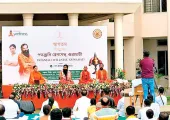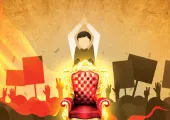Significance of Shivajaki's coronation
On

Prof. Kusumlata Kedia
Jyeshtha Shukla Trayodashi was the day of coronation of Chhatrapati Shivaji Maharaj. The significance of this is not known to contemporary Indians, because what was taught to Indians in the name of history was an attempt to mold those events according to the notions of certain sectarians rather than actual events and actions. Which is actually another name for a lie. To imagine first that Delhi was the capital of India forever and then to imagine that the vassal of Delhi automatically becomes the Chakravarti emperor of the whole of India, is so ridiculous in itself that it is worth calling things written from this point of view as history. But enlightened people all over the world despise those who say so.
Some British had also published maps of India at different times to clarify the fact. In particular, the map of Akbar's time, which was printed by those Britishers titled 'India' in 1561 AD, clearly showed that Akbar had jagirs in agreement with Hindu kings in Punjab, Kashmir and Uttar Pradesh and at the same time the vast area of Gondwana. There was a kingdom which was always under the Gond kings. Apart from this, there was entire Rajputana, Sindh province, Malwa kingdom, Vijaynagar kingdom, Bihar and many states of Bengal, the kingdom of Gujarat and Golconda etc., which were spread over an area ten times larger than the Akbari Jagir. But after 1947 AD it was taught in India that Akbar was the emperor of the whole of India. Similarly, false propaganda was made about Aurangzeb, when he ruled the Rajputs with great persuasion and respect, but by inciting old animosity between the Marathas and the Rajputs, he made the Rajputs fight with the Marathas. It must be said that his diabolical cruelty proves him to be inhuman and his echo in India in the form of hatred towards him has been engraved for a long time in India, which is natural. But to call him the king of the whole of India is completely untrue. The history of India is being taught to Indian students for the last 75 years in such a way that they could not know the truth. Why this is happening is a matter of separate discussion. But it is an unforgivable crime to reduce the popular empire of Chhatrapati Shivaji Maharaj. The truth is that Chhatrapati Shivaji Maharaj ended the animosity of the Marathas with the Rajputs because it was on their strength that the Muslim rulers had succeeded. It was the strength of the great diplomacy of Chhatrapati Shivaji Maharaj that within 5 years of his coronation, Aurangzeb had a fierce battle with the Rajputs and the support of the Rajputs to the Mughals ended forever.
Maharaj Jaswant Singh, whom Aurangzeb always used to please, those Maharajs broke ties with Shivaji because of Aurangzeb's policy towards him. Aurangzeb did not dare to climb Marwar while he was alive. But after his death Aurangzeb attacked Marwar. This created a deep opposition to the Mughals in the minds of the Rajputs. Similarly, Aurangzeb also had a heavy battle with Maharaj Jai Singh. Some other Rajputs had supported Aurangzeb in that war, due to which he had to make a treaty and support Aurangzeb for some years, but after the wrong behavior with Shivaji, Raja Jai Singh also distanced himself from the Mughals. To hide these facts is to hide the truth of history.
The truth is that in the 17th century AD, the Marathas had become the real rulers of India. That is why in order to get the suzerainty in India, the people of East India Company along with their allies Indians had to fight three or three times with the Marathas.
At the age of 19, Chhatrapati Shivaji Maharaj had captured the Torna fort near Pune. After that he conquered the forts of Raigad, Chakan, Sinhagad and Purandar. Then also took control of the forts of Kalyan and Jawali. He made all this effort within 9 years. He skillfully killed the evil Turk Afzal Khan, who was sent to kill him. After this, Shaista Khan, sent by Aurangzeb, was killed. Raja Jai Singh and had Udaybhan not come to fight for the side of the Mughals, Shivaji Maharaj would have been coronated in 1665 AD itself. This happened only after 9 years. Aurangzeb could never defeat Shivaji in battle. Then he sent a proposal of treaty through Maharaj Jai Singh and called Agra, but was taken prisoner there by deceit. So that Shivaji could come out with amazing skill.
All the Rajput kings got angry with Aurangzeb for his attempt to take Shivaji captive by breach of promise and deceit. This is the reason. That at the time of coronation of Chhatrapati Shivaji Maharaj, he had indirect support of all Rajput kings. Although due to Aurangzeb, he did not openly participate in the coronation. The fact is that since the coronation of Chhatrapati Shivaji Maharaj i.e. from 1674 AD, India was completely under Maratha and was with them.
Shambhuji Maharaj, the great heroic son of Chhatrapati Shivaji Maharaj, also continued to defeat Aurangzeb's armies valiantly. But in 1689 AD, he was imprisoned fraudulently and very brutally Aurangzeb killed him with a terrible vampire karma, cutting every part of him gradually. Aurangzeb had also taken Shivaji's grandson captive and after 18 years he was freed. Under the leadership of their Brahmin general Balaji Vishwanath, the Maratha Empire became stronger and under the leadership of Bajirao I and Balaji Bajirao, the whole of India became under the Marathas. The Rajputs had a treaty with them. Bajirao is first famous as Peshwa Bajirao. His name was also Bajirao Ballal. The tales of his power and valor had spread so far that in those days the Christian priests who were making false gossips about the history of India by forgery, even wrote that for centuries the great emperors of India were called Ballal or Balhar. is called. He also composed the stories of many fictional Balhal rulers.
In the early 18th century AD, Bajirao Peshwa was the world's largest and most valiant general. During his 20 years of Peshwa's life, he defeated both the Mughals and the Nizams badly and established the monopoly of the Marathas in South India, as well as established him as a universal emperor in all of North India. As is the Indian tradition, the bravest king of his time is accepted by all the rest of the kings and this acceptance is only out of respect and honor. Every king continues to rule in his own area and keeps on considering the emperor as paramount. In the event of war, he sends his armies to fight on the side of the emperor. In fact, the British followed this tradition of India after 1858 AD. took advantage and recognized the complete freedom of Indian kings to rule in their respective kingdoms and the treaty that the kings would help England at the time of war. Which benefited the British in the First and Second World Wars.
On 17 April 1720 AD, Bajirao Peshwa was appointed as the commander and within 20 years he established Maratha hegemony. He hoisted the saffron flag from Attock to Cuttack. Along with this, he further strengthened the administration run by the Ashtapradhan established since the time of Chhatrapati Shivaji Maharaj. The Mughal of K had surrendered to Bajirao Peshwa long ago, but Nizam insisted in Hyderabad that he would keep the right to collect Chauth in his area with himself. On this Bajirao Peshwa attacked against him and the defeated Nizam accepted Maratha suzerainty.
Bajirao I expanded the Hindu position of padshahi to the whole nation and took all the Hindu kings with him. Fearing this, the Nizam of Hyderabad requested the Peshwa that you should pay more attention to North India itself and do not disturb our state. Peshwa Bajirao I made a treaty with the descendants of Maharaj Jai Singh and with the descendants of Maharaj Chhatrasal and took Delhi as well. At that time Muhammad Shah, the heir of the Mughals, was the vassal of the limited area of Old Delhi there. He panicked and called the Nizam. The Nizam, following the tradition of ungratefulness of the Muslims, ran towards Delhi but was defeated by the Maratha forces near Bhopal. After this there was no rival of Marathas in India and Nizam also made a treaty out of fear. Then the Marathas badly surrounded the Portuguese trying to spread in Goa and drove them out of the area of Basai and Sashti. Bajirao I founded the Maratha Mandal and gave Gwalior region to Shinde, Baroda region to Gaikwad, Indore region to Holkar and Nagpur region to Bhosale. Thus the Maratha Empire became very vast. On this the East India Company took refuge in the Marathas and then tried to divide them. On the advice of the British, Bajirao II adopted a harsh policy regarding Nana Fadnavis and he also clashed with Shinde and Holkar. Bajirao II signed the treaty of Basai with the British in 1802 AD after being defeated by Holkar. After this there was a split in the Maratha powers. Which the British took advantage of. Thus Marathas were the real rulers of India from 17th century AD to 19th century AD. This is the significance of Shiva's coronation. What the new generation of India should know.
Tags: patanjali patanjali wellness yog sandesh education india bharat university of patanjali bharat swabhiman patanjali yog samiti swami ramdev ji maharaj patanjali gurukulam acharyakulam patanjali research institute Acharya balkrishna patanjali yogpeeth patanjali yog sandfdesh yog gram yog guru haridwar devbhumi mahila patanjali yog samiti patanjali ayurvedic hospital
लेखक
Related Posts
Latest News
01 Nov 2024 17:59:04
जीवन सूत्र (1) जीवन का निचोड़/निष्कर्ष- जब भी बड़ों के पास बैठते हैं तो जीवन के सार तत्त्व की बात...




